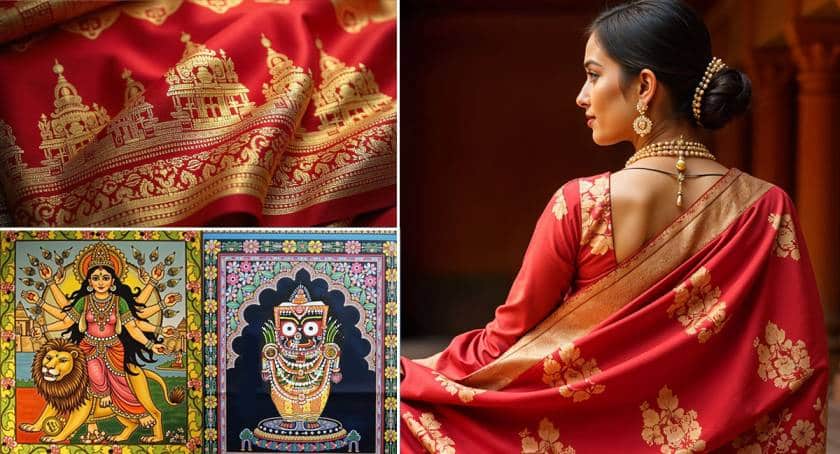Odisha’s Mythology & Temples Inspiring Saree Designs
Odisha, a land steeped in history and spirituality, is renowned for its magnificent temples, ancient myths, and vibrant culture. This eastern Indian state is home to some of the most revered temples in the country, including the Jagannath Temple in Puri, the Sun Temple in Konark, and the Lingaraj Temple in Bhubaneswar. These architectural marvels and the region’s deep-rooted mythology have profoundly influenced Odisha’s artistic traditions, particularly its beautiful handwoven sarees.
In Odisha, saree weaving is a centuries-old craft handed down through the generations by talented craftspeople. Every thread, motif, and color used in these sarees tells a story, often drawing inspiration from temple architecture and mythological narratives. The sarees reflect the grandeur of Odisha’s temples and embody its people’s devotion and artistic expression. This article delves into how Odisha’s mythology and temples inspire the designs of its traditional sarees, making them a cherished part of India’s textile heritage.
The Influence of Mythology on Odisha’s Saree Weaving
Odisha’s mythology, derived from ancient texts like the Mahabharata, Ramayana, and local folktales, is crucial in shaping its textile traditions. The legends associated with Lord Jagannath, in particular, are deeply embedded in the designs of Odisha sarees.
Jagannath Culture in Sarees
The annual Rath Yatra of Lord Jagannath, Balabhadra, and Subhadra is a significant event in Odisha. Weavers often incorporate the vibrant colors associated with the deities—red, yellow, and black—into their sarees. These colors symbolize divinity and auspiciousness, making them a common choice for religious and festive sarees.
Pattachitra Art in Sarees
Pattachitra, a traditional Odisha art form known for its complex mythological depictions, has also influenced saree weaving. Many Odisha sarees feature Pattachitra-inspired patterns, which narrate stories from Hindu epics and legends through fabric. These sarees are not just garments but also visual storytelling pieces, reflecting the artistic brilliance of Odisha’s artisans.
Animal and Nature Motifs
Mythology often attributes symbolic meanings to animals and natural elements. Odisha’s sarees feature motifs of elephants (representing wisdom and strength), peacocks (symbolizing beauty and grace), conch shells (signifying spiritual awakening), and lotus flowers (denoting purity and divinity). Drawing from temple sculptures and mythological narratives, these motifs add depth and cultural significance to the sarees.
The Influence of Temples on Odisha’s Saree Weaving
Odisha’s temples are characterized by complex carvings, towering spires, and elaborate sculptures depicting deities, celestial beings, and mythological tales. These architectural elements inspire Odisha’s weavers, who use unique weaving techniques to replicate temple designs in their sarees.
Temple Borders
A distinct feature of Odisha sarees is the incorporation of temple-inspired borders. The artisans translate the elaborate carvings on temple walls and pillars into geometric and symmetrical patterns on the sarees’ borders, often resembling temple spires, arches, and friezes. This style, popularly known as the ‘temple border,’ is prominently seen in Sambalpuri and Bomkai sarees.
Deity Motifs
Many Odisha sarees feature motifs of Hindu deities, reflecting the state’s strong spiritual traditions. Weavers intricately weave figures of Lord Jagannath, Odisha’s presiding deity, and representations of Goddess Lakshmi and the Sun God into the fabric. These motifs symbolize divine blessings and protection, making these sarees popular for religious occasions and festivals.
Chariot Wheel Patterns
One of the most iconic symbols of Odisha’s temple architecture is the chariot wheel from the Sun Temple at Konark. These complexly carved wheels, symbolizing time and movement, are a recurring motif in Odisha sarees. The weavers incorporate elegant wheel patterns into the pallu (the loose end of the saree), adding a touch of historical grandeur to the attire.
Major Odisha’s Sarees Inspired by Mythology & Temples
Several types of Odisha sarees showcase the influence of temples and mythology in their weaves. Here are some notable examples:
Sambalpuri Sarees
Sambalpuri sarees, renowned for their Ikat weaving technique, are deeply rooted in Odisha’s traditions. The tie-dye method in these sarees often features temple spires, chariots, and sacred symbols. Many designs draw inspiration from Lord Jagannath and the Sun God, reflecting Odisha’s rich spiritual heritage in these sarees.
Bomkai Sarees
Also known as Sonepuri sarees, Bomkai sarees depict mythological stories and temple art through their weaves. The borders and pallu of these sarees feature traditional motifs, such as fish (a symbol of prosperity) and Rudraksha beads (associated with Lord Shiva). These elements add a religious and cultural touch to the attire.
Berhampuri Silk Sarees
Berhampuri silk sarees hold a special place in Odisha’s temple traditions. People often wear them in rituals at the Jagannath Temple. The weaving patterns include temple structures and complex designs that mirror the sacred ambiance of Odisha’s holy sites.
Kotpad Sarees
Tribal weavers of Odisha create Kotpad sarees, which feature a natural dyeing process and unique motifs inspired by tribal mythology and nature. Many designs reflect temple structures and spiritual symbols, connecting them to Odisha’s rich cultural past.
Colors & Symbols in Odisha’s Sarees
Odisha’s saree designs heavily feature colors and symbols, each of which has mythological and spiritual connotations:
- Red & Yellow: Represent divinity and auspiciousness, often seen in sarees used for religious rituals.
- Black & White: Symbolize balance and cosmic harmony, frequently found in Lord Jagannath-inspired sarees.
- Conch & Chakra: Represent Lord Vishnu’s power and protection, commonly woven into the pallu.
- Peacock & Lotus: Symbolize beauty and purity, inspired by temple carvings and mythological themes.
Conclusion
Odisha’s sarees are not merely traditional garments but woven expressions of the state’s mythology, spirituality, and architectural grandeur. Their complex patterns, temple-inspired motifs, and mythological references make them timeless art masterpieces. Each Sambalpuri Ikat, Bomkai silk, or Pattachitra-adorned saree tells a story of devotion, heritage, and artistic excellence.
Wearing an Odisha saree is akin to draping oneself in the essence of the state’s culture and history. Through these carefully crafted fabrics, the weavers of Odisha continue to keep their ancient traditions alive, ensuring that the legacy of temple art and mythology endures for generations to come.


